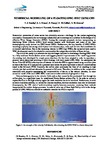Numerical Modelling of a Floating OWC-WEC Using CFD
| dc.contributor.author | Ransley, E | |
| dc.contributor.author | Brown, Scott Andrew | |
| dc.contributor.author | Howey, B | |
| dc.contributor.author | Collins, K | |
| dc.contributor.author | Greaves, Deborah | |
| dc.date.accessioned | 2019-04-04T09:42:02Z | |
| dc.date.available | 2019-04-04T09:42:02Z | |
| dc.date.issued | 2017-07-06 | |
| dc.identifier.uri | http://hdl.handle.net/10026.1/13621 | |
| dc.description.abstract |
Economical conversion of ocean waves into electricity remains a challenge for the marine engineering community. Consequently the wave energy industry has yet to converge on a solution for the design of an effective Wave Energy Converter (WEC). Among the concepts proposed, devices incorporating an Oscillating Water Column (OWC) have proven popular with developers and many of the most technologically ready devices are OWC-based WECs. Furthermore, the key benefits of OWC-WECs, including simplicity and strong reliability/survival characteristics, make such devices ideal candidates for co-located installations. Due to the increasing interest in OWC-type WECs, the numerical tools used in WEC development need to be adapted to accommodate the unique characteristics of these devices. The aim of this study is to ascertain the key challenges involved in simulating a floating OWC-WEC in a fully nonlinear Navier-Stokes solver and suggest potential improvements to the modelling process. An existing tool, developed for simple point-absorbers [1], has been adapted in order to reproduce a physical heave decay test involving a freely-floating, 1:40 scale model OWC-WEC. As anticipated, the Power Take-Off (PTO) is the key area of interest. At scale the PTO is approximated using an orifice plate to restrict the flow of air and provide a pressure head across the plate equivalent to that of a scaled turbine (used in the full-scale PTO). Crucially, the orifice plate accelerates the flow of air resulting in high velocity jets that would not otherwise be present at full-scale. Therefore, in addition to the complexities associated with properly representing the compressibility of the air in the internal chamber, an exact numerical model of the scale OWC-WEC must accommodate relatively high speed air flow. Extreme heterogeneity in the velocity field, such as that caused by the accelerated flow through the orifice plate, is a significant issue for mesh-based Navier-Stokes solvers (Fig. 1). In order to correctly capture the flow in the high-velocity region the mesh resolution has to be increased. Furthermore, in order to retain simulation stability, i.e. satisfy the Courant condition, the time-resolution must also be increased. Consequently, the CPU cost of such simulations rapidly becomes excessive, rendering these methods inappropriate for routine design processes. In order to make use of these high fidelity tools in the design process of OWC-WECs an alternative method to describe the PTO is required. | |
| dc.language.iso | en | |
| dc.title | Numerical Modelling of a Floating OWC-WEC Using CFD | |
| dc.type | conference | |
| plymouth.date-start | 2017-07-06 | |
| plymouth.date-finish | 2017-07-07 | |
| plymouth.conference-name | 4th PRIMaRE Conference | |
| plymouth.organisational-group | /Plymouth | |
| plymouth.organisational-group | /Plymouth/Faculty of Science and Engineering | |
| plymouth.organisational-group | /Plymouth/Faculty of Science and Engineering/School of Engineering, Computing and Mathematics | |
| plymouth.organisational-group | /Plymouth/PRIMaRE Publications | |
| plymouth.organisational-group | /Plymouth/REF 2021 Researchers by UoA | |
| plymouth.organisational-group | /Plymouth/REF 2021 Researchers by UoA/UoA12 Engineering | |
| plymouth.organisational-group | /Plymouth/Research Groups | |
| plymouth.organisational-group | /Plymouth/Research Groups/Marine Institute | |
| plymouth.organisational-group | /Plymouth/Users by role | |
| plymouth.organisational-group | /Plymouth/Users by role/Academics | |
| plymouth.organisational-group | /Plymouth/Users by role/Researchers in ResearchFish submission | |
| dc.publisher.place | Southampton | |
| dcterms.dateAccepted | 2017-05-31 | |
| dc.rights.embargoperiod | Not known | |
| rioxxterms.licenseref.uri | http://www.rioxx.net/licenses/all-rights-reserved | |
| rioxxterms.licenseref.startdate | 2017-07-06 | |
| rioxxterms.type | Conference Paper/Proceeding/Abstract |


